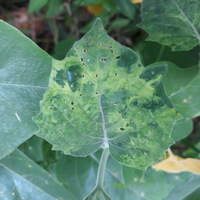In several Paraguay regions, papaya trees (Carica papaya) occur naturally in particular gardens and public spaces. Although PRSV-like symptoms have been frequently observed in papaya trees in Paraguay, no formal description of PRSV is... more
In several Paraguay regions, papaya trees (Carica papaya) occur naturally in particular gardens and public spaces. Although PRSV-like symptoms have been frequently observed in papaya trees in Paraguay, no formal description of PRSV is available.
Research Interests:
Cucurbits are among the most important crops for the rural family’s economies of many departments of Paraguay, due to the favorable markets at national and international level. In July 2018, mosaic, leaf deformation, chlorosis and... more
Cucurbits are among the most important crops for the rural
family’s economies of many departments of Paraguay, due to
the favorable markets at national and international level. In
July 2018, mosaic, leaf deformation, chlorosis and stunting
were observed in plants of Cucurbita maxima var. Zapallito
in an experimental area located in the campus of the National
University of Asuncion, San Lorenzo County, Central
Department, Paraguay.
family’s economies of many departments of Paraguay, due to
the favorable markets at national and international level. In
July 2018, mosaic, leaf deformation, chlorosis and stunting
were observed in plants of Cucurbita maxima var. Zapallito
in an experimental area located in the campus of the National
University of Asuncion, San Lorenzo County, Central
Department, Paraguay.
Research Interests:
Soil-borne viruses transmitted by Polymyxa graminis can lead to major yield losses in wheat crops worldwide. This work describes the identification of a soil-borne virus infecting wheat plants in Paraguay. Based on electron microscopy... more
Soil-borne viruses transmitted by Polymyxa graminis can lead to major yield losses in wheat crops worldwide. This work describes the identification of a soil-borne virus infecting wheat plants in Paraguay. Based on electron microscopy observations of virus particles in symptomatic leaf and molecular assays the virus was identified as wheat stripe mosaic virus (WhSMV). To our knowledge, this is the first report of WhSMV in Paraguay.
Research Interests: Plant Virology and Wheat
Tospovirus can lead to major yield losses in several crops worldwide. This work describes the identification of a tospovirus infecting tomato and petunia plants. Based on molecular assays, the virus was identified as Groundnut ringspot... more
Tospovirus can lead to major yield losses in several crops worldwide. This work describes the identification of a tospovirus infecting tomato and petunia plants. Based on molecular assays, the virus was identified as Groundnut ringspot tospovirus (GRSV). To our knowledge, this is the first report of GRSV in Paraguay.
Research Interests:
Research Interests:
Background: Cowpea [Vigna unguiculata (L) Walp.] is one of the Paraguayan rural families' main crops, serving as an essential protein and carbohydrate source. Cowpea aphid borne mosaic virus (CABMV) and cowpea severe mosaic virus (CPSMV)... more
Background: Cowpea [Vigna unguiculata (L) Walp.] is one of the Paraguayan rural families' main crops, serving as an essential protein and carbohydrate source. Cowpea aphid borne mosaic virus (CABMV) and cowpea severe mosaic virus (CPSMV) were identified infecting cowpea plants. Disease control caused by both viruses is difficult because there is no information about local cowpea resistant cultivars and vector control is not practical. Methods: In the present work, sixteen cowpea genotypes/cultivars were mechanically inoculated with local isolates of CABMV and CPSMV to identify resistant genotypes/cultivars that can be used in breeding programs. Virus infections were determined by symptoms expression and confirmed by PTA-ELISA. Result: Genotypes Arroz rojo (V. angularis), TVu 379, TVu 382, TE94-256-2E and TE97-309G-9 were resistant to CABMV. Genotypes Arroz rojo (V. angularis), CNCX-698-128F, TVu 379, TVu 382, TVu-3961, TE97-309G-9 and TE97-309G-3 were resistant to CPSMV. Overall, this study showed that local cowpea cultivars do not offer any resistance to virus infection and the need for resistant germplasms for cowpea breeding programs in the country.
Research Interests:
Despite an economy based mostly on agriculture, literature on viral diseases of plants is scarce in Paraguay. Only recently, researches on plant viruses took an impulse resulting in a precise identification of many of them affecting... more
Despite an economy based mostly on agriculture, literature on viral diseases of plants is scarce in Paraguay. Only recently, researches on plant viruses took an impulse resulting in a precise identification of many of them affecting plants either cultivated or not. To provide reliable information regarding plant viruses present in Paraguay, an annotated list of them was prepared, covering descriptions from 1920 to present day. There have been some important outbreaks with severe yield losses in crops as cucurbits, citrus, sesame, bean, maize, peanuts and tomato. Many of older descriptions are included for their historical significance, but most identifications made require confirmation. On the other hand, recent descriptions have been completed, based on several assays, especially molecular characterization. This list is organized alphabetically following scientific names of the plant species found naturally infected by viruses, with comments about symptoms, geographical distribution, incidence, identification procedures, and other information, with due literature references. It is based on a compilation of publications made on plant virus diseases in Paraguay. Described virus species, in a total of 38 recognized by ICTV, belonging to 17 different genera (Alphaendornavirus,
